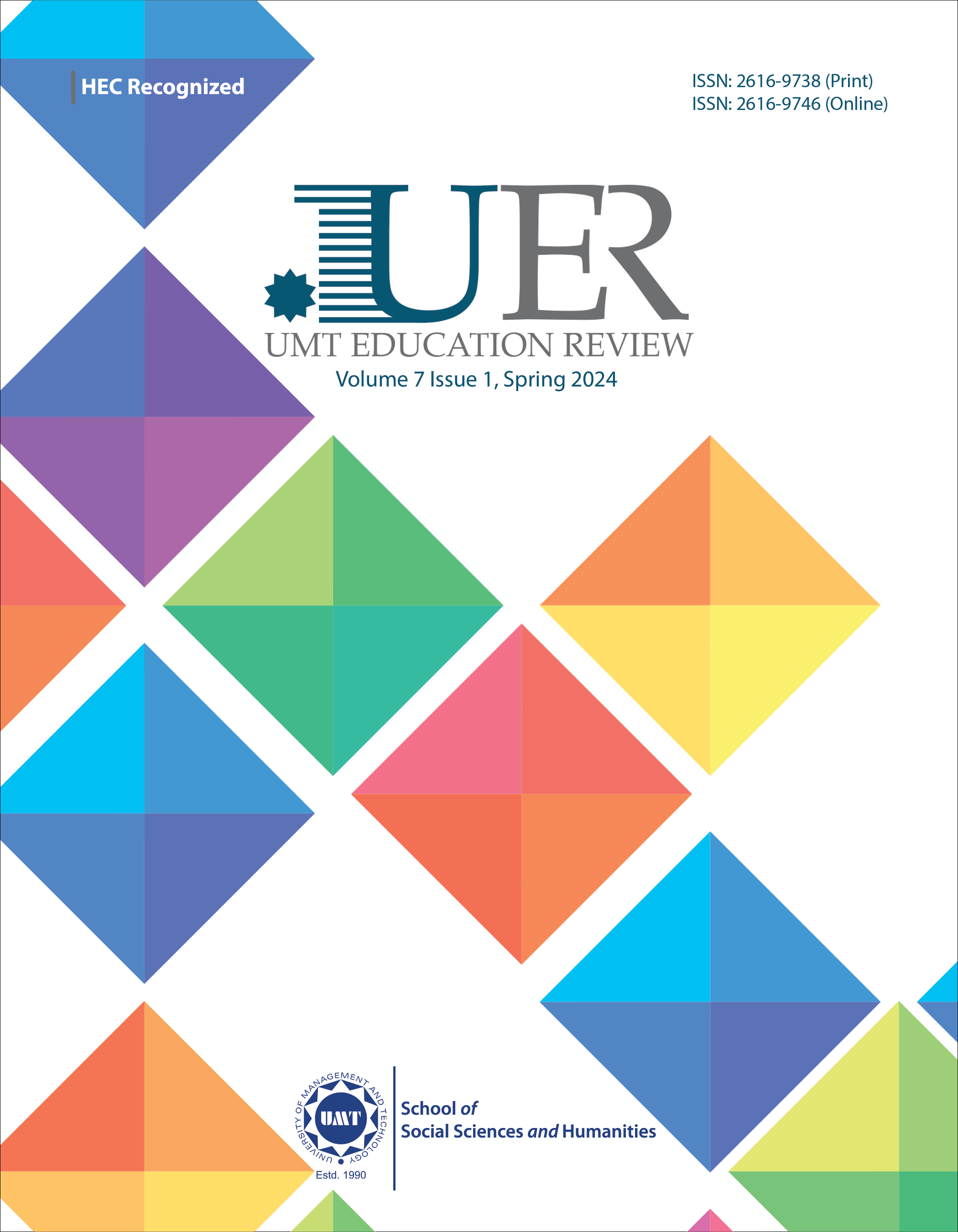Effectiveness of Outdoor Learning Activities: Perspectives of Primary School Teachers
Abstract
 Abstract Views: 0
Abstract Views: 0
Students who participate in a variety of outdoor activities improve their problem-solving skills, acquire useful knowledge, strengthen their resilience in the face of adversity, and form a closer bond with nature. Engaging students in outdoor learning activities offers a means of fostering nature interactions within the school setting. The study aimed to explore teachers’ perspectives on the effectiveness of outdoor learning activities. This study was descriptive in nature and adopted survey method to collect data from the participants. The sample comprised of 270 primary school teachers in the Sialkot district. A questionnaire was developed to assess the effectiveness of outdoor learning at primary level, comprising 21 statements related to cognitive, affective and psychomotor learning of primary school students. Findings of the study revealed that primary school teachers perceive outdoor learning activities effective for the development of cognitive, affective and psychomotor abilities of primary school students. However, there are significant differences in perspectives between male and female teachers regarding the effectiveness of outdoor learning at primary school level. It is recommended that professional training should be conducted to train teachers to incorporate outdoor learning activities effectively into primary education.
Downloads
References
Amos, R., & Reiss, M. (2012). The benefits of residential fieldwork for school science: Insights from a five-year initiative for inner-city students in the UK. International Journal of Science Education, 34(4), 1–27. https://doi.org/10.1080/09500693.2011.585476
Anderman, E. M. (2009). School effects on psychological outcomes during adolescence. Journal of Educational Psychology, 94(4), 795–809. https://psycnet.apa.org/doi/10.1037/0022-0663.94.4.795
Andersson, B. E., & Strander, K. (2004). Perceptions of school and future adjustment to life: A longitudinal study between the ages of 18 and 25. Scandinavian Journal of educational Research, 58(5), 459–476. https://doi.org/10.1080/003138042000272122
Anđić, D., & Mažar, S. (2023). Teachers’ connectedness to nature, education for sustainable development and the contemporary teaching of the subject “nature and society” in croatian schools. Journal of Teacher Education for Sustainability, 25(1), 86–97. https://doi.org/10.2476/jtes-2024-0009
Azzarito, L., & Solomon, M. A. (2005). A reconceptualization of physical education: The intersection of gender/race/social class. Sport, Education and Society, 10(1), 25–47. https://doi.org/10.1080/135733205200028794
Becker C., Lauterbach G., Spengler S., Dettweiler U., & Mess F. (2017). Effects of regular classes in outdoor education settings: a systematic review on students’ learning, social and health dimensions. International Journal of Environmental Research and Public Health, 14(5), Article e485. https://doi.org/10.3390/ijerph14050485
Gilchrist, M., Passy, R., Waite, S., & Rachal, C. (2016). Exploring Schools Use of Natural Spaces. In C. Freeman, P. Tranter, & T. Skelton (Eds.), Risk, protection, provision and policy. Singapore.
Gray, T. (2018). Outdoor learning: Not new, just newly important. Curriculum Perspect. 38, 145–149. https://doi.org/10.1007/s41297-018-0054-x
Gromada, A., Gwyther, R., & Yekaterina, C. (2020). Worlds of Influence: Understanding What Shapes Child Well-being in Rich Countries. UNICEF. https://www.unicef.org/innocenti/reports/worlds-of-influence
Hattie, J., Marsh, H. W., Neill, J. T., & Richards, G. E. (1997). Adventure education and Outward Bound: Out-of-class experiences that make a lasting difference. Review of Educational Research, 67(1), 43–87. https://doi.org/10.3102/00346543067001043
Iipinge, S. M. (2013). Challenges of large class teaching at the university: implications for continuos staff development activities. The Namibia CPD Journal for Educators, 1(1), 105–12. https://doi.org/10.32642/ncpdje.vi.1263
Jurčić, M. (2015). Education in extracurricular classes. In S. Opić, V. Bilić & M. Jurčić (Eds.), Education in school. Zagreb
Kocayiğit, A., & Ekinci, N. (2020). Evaluation of extra-curricular activities implemented in high schools according to teachers’ opinions. OPUS International Journal of Society Researches, 16(29), 1810–1848.
Kuo, M., Browning, M., & Penner, M. (2018). Do lessons in nature boost subsequent classroom engagement? Refueling students in flight. Frontiers in Psychology, 8, Article e2253. https://doi.org/10.3389/fpsyg.2017.02253
Liu, J., & Green, R. J. (2023). The effect of exposure to nature on children’s psychological well-being: A systematic review of the literature. Urban Forestry & Urban Greening, 81, Article e127846. https://doi.org/10.1016/j.ufug.2023.127846
Prado, M., Masset, T., Fernani, D., & Monteiro, C. B. (2016). Analysis of psychomotor development and level of physical activity of children with extracurricular physical activities. Acta Fisiátrica, 23(4), 208–212. https://doi.org/10.5935/0104-7795.20160039
Putnam, R., McCart, A., Griggs, P., & Choi, J. H. (2009). Implementation of schoolwide positive behavior support in urban settings. In W. Sailor, C. Dunlap, G. Sugai & R. Horner (Eds.), Handbook of positive behavior support (pp. 443–463). Springer.
Rickinson, M., Dillon, J., Teamey, K., Morris, M., Choi, M., Sanders, K., & Benefield, P. (2004). A review of Research on Outdoor Learning. National Foundation for Educational Research.
Sahlberg, P. (2016). The global educational reform movement and its impact on schooling. In K. Mundy, A. Green & A. Verger (Eds.), The handbook of global education policy. (pp. 128–44). Wiley Online Library. https://doi.org/10.1002/9781118468005.ch7

This work is licensed under a Creative Commons Attribution 4.0 International License.
UER follows an open-access publishing policy and full text of all published articles is available free, immediately upon publication of an issue. The journal’s contents are published and distributed under the terms of the Creative Commons Attribution 4.0 International (CC-BY 4.0) license. Thus, the work submitted to the journal implies that it is original, unpublished work of the authors (neither published previously nor accepted/under consideration for publication elsewhere). On acceptance of a manuscript for publication, a corresponding author on the behalf of all co-authors of the manuscript will sign and submit a completed Copyright and Author Consent Form.
Copyright (c) The Authors










